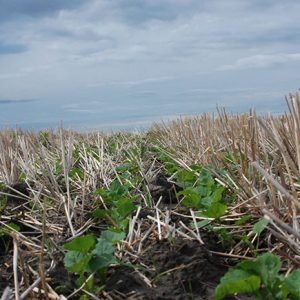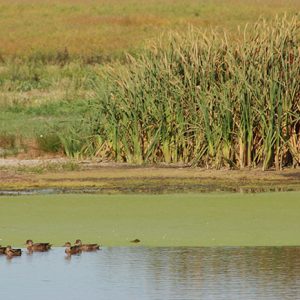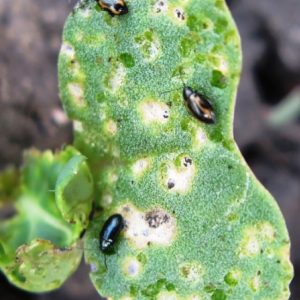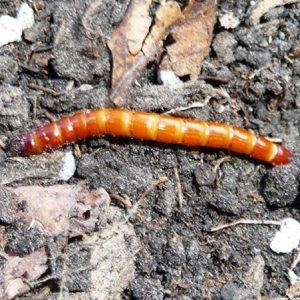
Features
Agronomy
Insecticides
The future of neonics
Breaking down the re-evaluations and next steps for this form of pest control.
June 21, 2020 By Presented by John Gavloski, Manitoba Agriculture and Resource Development, at the Top Crop Manager Plant Health Summit, Feb 25-26, 2020, Saskatoon.
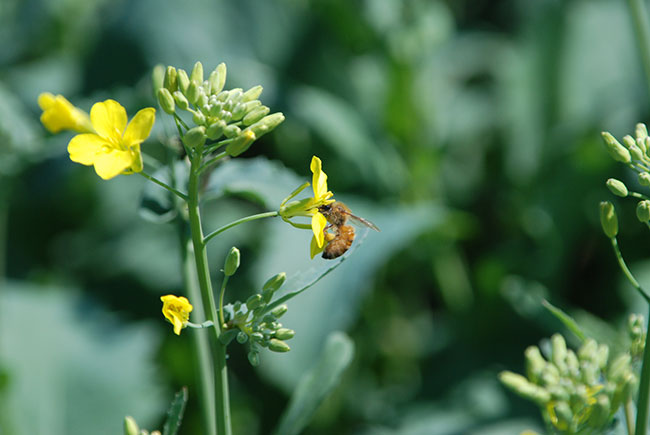 Photo by Bruce Barker.
Photo by Bruce Barker.
Neonicotinoid (neonic) insecticides have recently come under a lot of scrutiny. They belong to Insecticide Group 4A and in Western Canada are used mainly as seed treatments in field crops. The seed treatments that you’re probably familiar with are ones like Helix, Poncho, Prosper, Cruiser, and Raxil. There are also several different active ingredients for neonics and the three that I am going to focus on are imidacloprid, thiamethoxam, and clothianidin. These are the three that are undergoing reviews by Health Canada’s Pest Management Regulatory Agency (PMRA).
There are three separate re-evaluations for neonics going on. All of our pesticides go through cyclical re-evaluations. A product will be re-evaluated just to make sure that nothing has changed, that the label doesn’t need to be amended, and so new science can be factored into that product’s status and use patterns. In addition to these cyclical evaluations, PMRA does “special reviews” in response to an issue that might arise.
In this presentation we will explore why there has been so much controversy over neonics, and, if they were to be phased out, what the alternative insect management options are.
Special review on pollinators
PMRA initiated a pollinator focused re-evaluation on neonics in 2012, because it was noted that pollinators were being killed and neonics were thought to be a potential cause. The final decision was published April 11, 2019.
The final decision was that many of the foliar applications were cancelled in flowering crops that bees find attractive, such as orchard trees. For some fruiting vegetables and berry crops, foliar sprays are not allowed right before or during flowering. The assessment was that use as seed treatments was still acceptable, but the labels had to have a statement that exposure of pollinators to dust had to be minimized when applying to cereals and legumes.
Cyclical re-evaluation of imidacloprid
A cyclical re-evaluation was completed a few years ago on imidacloprid, and the proposed decision came out in November 2016. PMRA proposed to discontinue all agricultural uses of imidacloprid. This was based on water quality data, mainly from Eastern Canada where detections were exceeding the acceptable threshold of 41 nanograms per litre (ng/L). That threshold is also controversial.
But this isn’t the final decision. When a review comes out, initially it’s a proposed decision. Individuals and organizations get a certain period of time to respond to this proposal. If there’s science or implications that we think might have not been considered, we can add that to the picture. The final decision is expected later in 2020.
Aquatic special reviews of clothianidin and thiamethoxam
After the imidacloprid cyclical review, it became evident that there’s potential groundwater and surface water issues with neonicotinoids, and a special aquatic review was done on the other two neonics, thiamethoxam and clothianidin. Once again, the review is in the proposed phase, and what was proposed was the phase out of all outdoor uses of these two insecticides. This again was based on water quality data.
Initially, PMRA was supposed to have their final decision out late 2019, but there was a lot of feedback and new information submitted. Now we’re expecting the final decision to occur probably in the fall of 2020.
How neonics work
One of the things that make neonics really good insecticides is that they’re very highly toxic to insects. They also have low toxicity to vertebrates, which means less risk to humans. The oral LD50 [median lethal dose] to mammals of a lot of these products is actually quite high (meaning less toxic), into the thousands, which compares favourably to an insecticide like Furadan that had an LD50 around seven.
Neonics are also systemic and move in the plant in the xylem, which means they can be very useful as seed treatments because xylem is moving from the roots up through the plant, into the leaves. Early in plant growth, it is highly concentrated in the new leaves, but as more leaves form, you get less and less neonic concentrations until eventually it’s not going to do its job anymore.
They are persistent too. Persistence can have a good and a bad side to it. On the good side, they hang around long enough to do the job. On the bad side, if they’re too persistent, they end up where you don’t want them to end up.
Neonic dust and pollinators
When growers use treated seed, for some crops it is helpful to have a lubricant to make the seed flow better through the planters. A typical practice for corn and soybean growers was to throw in talc or graphite that would help the seed flow better. But there is some abrasiveness and some of the seed treatment can come off of the seed. There is often a cloud of dust behind the planter at seeding time, and that dust could contain neonic insecticide in it. And this can be harmful to pollinators.
Early in the season, honey bees don’t have a lot to feed on, so they’ll be going to things like dandelions and some of the flowering plants along your field margins, and they might be flying through the fields at the time of seeding. There have been some significant bee kills because of dust from seeders. Once the connection between the dust from seeding and pollinator kill became known, growers were encouraged to use practices that could minimize the dust. Deflectors are one option, as they direct the dust to the soil surface.
Bayer also came out with a “fluency agent” that is a lubricant. There was a study in Ontario that looked at 18 fields and they found that there was 68 per cent less dust, but the dust had 3.7 times the concentration of neonics. The end result was about a 28 per cent reduction in neonic dust coming out of the seeders. So the fluency agent helps, but other dust reduction measures, such as deflectors, are still encouraged.
Neonics in pollen, nectar and guttation fluids
Other sources of potential exposure for pollinators to neonics are pollen and nectar. There was a study that determined the dose of neonics to get abnormal foraging behaviour in honey bees was greater than 40 parts per billion (ppb).
A study in canola, seeded with clothianidin in the seed treatment at label rates, measured the level of neonic residues in nectar and pollen. About 3 ppb was found in the pollen and about 3.7 ppb in the nectar. These levels are probably biologically insignificant, but, again, the concern was that it’s still there.
Honey bees also like to feed on pollen. Corn is a good pollen-producer, and honey bees really like corn pollen. Another study looked at neonic levels in pollen samples from corn, seeded with clothianidin in the seed treatment at label rates, and found about 3.9 ppb. Once again you probably won’t see abnormal behaviours in the bees at those levels.
Another study showed neonics showing up in “guttation fluids” of seed-treated corn plants. Guttation fluids are the excretion of xylem fluids at leaf margins. If you ever go out early in the morning when you’re doing your crop scouting, you might notice drops of water along the edges or margins of the leaves. That’s guttation fluids. Researchers took samples of these guttation fluids and analyzed them for neonics.
Neonics are highly water-soluble, so you’d expect they would be there, and they were. But again, the question biologically is “Does this mean anything to pollinators?” Pollinators do need water, but how much are they feeding on guttation fluids? We really don’t have a good answer to that question.
Neonics and surface water
Neonics in surface waters is another very controversial topic. Neonics are highly water-soluble so they make good seed treatments, but they end up in water quickly. Their half-life in water is fairly long, so they will persist in water. And they have a fairly high leaching and runoff potential.
I am going to show results from four studies on neonics in waterways. Some studies show that heavy rain events in the spring can produce pulses of neonics into waterways. Results aren’t always consistent between studies. Weather conditions, and how much rain you’ve been getting, can affect levels of movement into waterways.
The reason that neonics in surface water matters is that insects are really important in the aquatic food chain. Three groups of insects that are all very sensitive to neonicotinoids are mayflies (Ephemeroptera), caddisflies (Tricoptera) and Diptera (which includes midges). Fishermen will probably know these groups of insects. One of the standard test organisms, Daphnia magna appears to be very tolerant to neonics. Fish, amphibians and molluscs are also relatively insensitive to neonics.
The first of the four studies I’m going to show you was done in Saskatchewan. They looked at 136 wetlands in 2012 and 2013. Water sampling was done over four time periods – right before seeding in 2012, during the growing season, at harvest, and then early the next spring in 2013. There was a fairly high percentage of wetlands where neonics were detected. For example, during the summer of 2012, neonics were detected in 62 per cent of those 136 wetlands. Not all of those had concentrations that were likely biologically significant. But they did detect neonics in the water samples in all four of their sampling periods, and again that alone created a lot of alarm and controversy.
Study number two was done in the Corn Belt of the U.S. Midwest. The researchers took water samples out of nine streams over different time periods. They found neonics in all nine streams. The levels varied greatly depending on when they took their sample. One of the conclusions in this study was that rainfall events following seeding resulted in pulses of neonics into the streams.
Study number three was done in Ontario by Art Schaafsma and collaborators from the University of Guelph. Water samples were taken from puddles in corn fields, and also samples from puddles, ditches and drains outside of corn fields. They also looked at a couple soil samples taken from a conservation area nearby. They found clothianidin and thiamethoxam in virtually all the water samples. Within the corn fields, residue levels increased six-fold during the first five weeks after planting.
The neonics were quite a bit higher, at 2.41 ng/ml, than in the Saskatchewan study. In fact, they’re about 13-fold greater than the levels that were found in the Prairie Pothole study in Saskatchewan. But, again, you have to be careful when you’re looking at these studies, too – where the water was taken from, and what the rainfall conditions were like. There’s a lot of variability with these studies.
The two soil samples from the conservation area contained detectable levels of clothianidin. The big question was, “How were the neonics getting into the soil samples from this conservation area?” It may have been dust from the seeders at seeding time, or soil blowing, or a foliar spray from a potato field nearby. I don’t think they really know, and this is an interesting question from that study.
The fourth study was done in Manitoba in 2017. Water was collected from 33 surface water sites and eight ground water sites. Thiamethoxam was the most commonly detected in 20 sites, followed by clothianidin and imidacloprid. The sites were along major rivers, streams, and lakes like the Red River, Lake Winnipeg or a major stream.
PMRA has set proposed threshold levels for aquatic life for each neonic. For imidacloprid it is 41 ng/L, thiamethoxam is 26 and clothianidin is 1.5. The tricky part is scientists sometimes disagree about what acceptable levels to protect aquatic life should be. In PMRA’s report on the water quality data in 2017, they chose the 41 ng/L level to compare their data.
In this Manitoba study, post-seeding, two of the 31 sites had levels above 41 ng/L for thiamethoxam and two for clothianidin. During the growing season, one imidacloprid, five thiamethoxam, and five clothianidin sites had concentrations higher than 41 ng/L. After harvest, the numbers dropped to three for imidacloprid and one for clothianidin.
So the big question now is whether 41 ng/L is a good benchmark? That’s something that’s being highly debated. There are also different groups that have their own guidelines, including the Canadian Council of Ministers of the Environment, the US EPA and the EU. This is where it gets really tricky and controversial.
The other consideration is that neonicotinoids are often found as mixtures, which can have additive toxic effects on aquatic life, as they are all working on organisms in the same way. So if you had 30 ng/L of thiamethoxam and 35 ng/L of clothianidin you’re now up to 65, so you could have biological effects happening. So that’s the other thing that has to be considered when the PMRA is evaluating this data.
Minimizing surface water risk
There are a few things that can be done to reduce the risk of neonics moving into surface water. A study done in Saskatchewan found that neonics were found in fairly high levels (43 per cent) in wetland plants around sloughs and waterways. Field horsetails, northern water plantain and broadleaf cattails had high rates of detection of neonics. Unvegetated wetlands had higher concentrations of clothianidin and thiamethoxam than vegetated wetlands.
Neonics should only be used when necessary. In some instances, more regular use of insecticide-treated seed is justified, such as for flea beetles in canola. For potato growers or horticultural operations, where foliar application of Admire or Alias might be necessary, read your label. Any of the neonicotinoid foliar spray labels, read: “Avoid application when heavy rain is forecast.” In general, if you’ve got something that’s highly water-soluble, do not be putting it on before heavy rain is expected. Your chances of getting that into your waterways is magnified.
Alternatives to neonics
Canola is one of the crops where neonics are very heavily needed for flea beetle protection. Right now the alternative is an insecticide Group called the diamides, with product names of seed treatments like Lumiderm and Fortenza Advanced. There are pros and cons to some of these products. The diamides aren’t quite as water-soluble as the neonics, so the trade-off is that they might be a little bit slower acting. However, they do a very good job of killing flea beetles. Currently the diamides are more expensive than the neonics.
Looking further ahead, something I’m quite excited about is a new concept in insecticides. It’s called RNA interference. Genetic material specific to an insect is used to make an insecticide. When the target insect ingests the material, it silences genes inside that insect and kills it. It’s very targeted and will only kill flea beetles. This is being worked on and a company I talked to hope to have something to release by about the mid-2020s.
In cereal crops, the only insect that the neonics are used to manage in Western Canada is wireworms. So you really don’t need a neonic like Cruiser or Raxil on your cereals if you do not have a wireworm issue.
A year ago, I would have said there are no alternatives to neonics for wireworms. However, Lumivia is now registered in cereal crops for wireworm control. Lumivia is a diamide, and is the same active that is in Coragen, a foliar insecticide that’s highly toxic to grasshoppers and a lot of chewing insects.
In soybeans and pulse crops, the main reasons to use a neonic are wireworms or seedcorn maggot. In Manitoba, these are a very localized, sporadic concern. They’re not widespread at economic levels, so most soybean growers don’t need a neonic on their seed. However, many soybean growers were using neonic-treated seed because that is what they were sold. Again, we’re suggesting to use these in a more targeted way.
We do have seed treatments coming onto the market in pulse crops and soybeans as well. Fortenza is another diamide with the active ingredient cyantraniliprole that is registered on soybean. It’s the same active that is used in Fortenza seed treatments in corn and canola
Scorpio Ant and Insect Bait can provide suppression of wireworms. I don’t know how practical it is. It is a bait in a granular formulation that you have to mix with the seed. It contains spinosad. It will help repel wireworms and make them a little sick, just like the neonics do. I don’t know how much it’s going to be used in the Canadian Prairies, but it is registered as an alternative.
For corn growers, wireworms are the main reason to use a seed treatment, and sometimes seedcorn maggot. Corn rootworm shouldn’t be a problem with proper crop rotations. They only feed on corn, but we sometimes have a hard time getting people to rotate their corn if they’ve got livestock operations.
An alternative seed treatment in corn is once again the diamides. Fortenza is an option on wireworm and cutworms. An organophosphate, Pyrifos 15G is registered on corn rootworm. I don’t think a lot of people are using it. We do have corn rootworm-resistant corn varieties and people who have had problems in Manitoba have been exploring their use.
In potatoes, neonics use is a lot more widespread. They are used as a seed treatment on the potato or as an in-furrow foliar application at seeding. Products like Admire, Actara, or Alias are also used as a foliar spray. The main insects of concern are wireworms, aphids, leafhoppers, Colorado potato beetles, and potato flea beetle.
If neonics were phased out, potato growers have a few options. Capture (bifenthrin) is registered for wireworm control. I don’t know that it’s widely used. It is a very persistent product, can be hard on some of the natural enemies, and may not always be permitted by those buying potatoes.
Another registered option for wireworm control is chlorpyrifos products like Pyrifos 15G and Phyrinex. But these products are often not a practical option because they are not on the permitted products list of some companies that buy potatoes.
Another insecticide for wireworms in potatoes is Thimet 20-G. It is a granular product but has been heavily regulated because of toxicity. The only way you can apply it is in a “smart box” on the seeder that administers the product. I think because of the inconvenience, not a lot of people are using it.
Down the road, at least for wireworms, there is a new, quite exciting product coming out. Broflanilide will be on the market in the next year or two, and it actually kills wireworms very similar to what lindane used to do. Initially it’ll likely be registered in cereals and potatoes, and after that the label will probably be expanded to other crops.
Sustainable neonic use
Some studies in the U.S. looked at using “prairie strips” to reduce soil erosion, but the benefits extended beyond soil management. Narrow bands of often native vegetation were planted along contours and at bases of slopes in the field. In one of the studies done in the U.S. Corn Belt, they found that neonic concentrations in water and soil were lower in fields that had the prairie strips.
Responsible marketing, as well as responsible use, is essential for sustainable use of neonics. A few years ago, neonics were being promoted as growth promoters and for use as a “Vigour Trigger,” even if no insect pests were a threat. If we want to keep neonics as a tool in our toolkit, we need to use them as only insecticides and where risk is highest.
Assuming we keep our neonics, we have to be thinking very carefully about where and how we’re using them. Flea beetle control is probably essential. Wireworm and seedcorn maggot control is maybe required at times. We should be finding out the fate of neonics this fall 2020, but in the meantime, don’t overuse them.
